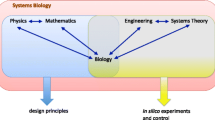
Overview
- An excellent introduction to systems biology
- Helps to understand genetic and chemical regulation in complex biological systems
- This book is open access, which means that you have free and unlimited access
- Explains the basic principles and cause-effect relationships of biological systems
Buy print copy
Tax calculation will be finalised at checkout
About this book
This open-access textbook is an excellent introduction to systems biology, which has developed rapidly in recent years. It discusses the processes in living organisms in an integrated way, enabling the reader to understand the fundamental principles and cause-effect relationships in biology and biochemistry. The authors have chosen an original but at the same time clear way of presenting the topics, repeatedly drawing comparisons and models from the macroscopic world and making the reader aware of the unity of the laws of physics, chemistry and biology.
The fully updated 2nd edition also contains information that has only become available as a result of the increase in knowledge in recent years. This includes information on tumorigenesis, where significant progress has been made due to the explosive development of genetic knowledge as well as bioengineering with a highly effective technique adopted from the solutions of the bacterial world, such as CRISPR/CAS.
Thisrichly illustrated book is essential for postgraduate students and scientists of the following disciplines: biology, biotechnology, medicine, bioinformatics, robotics and automation, biocybernetics, and biomedical engineering. It is also an exciting read for anyone interested in biology.
Similar content being viewed by others
Keywords
Table of contents (5 chapters)
Authors and Affiliations
About the authors
Prof. Irena Roterman-Konieczna, PhD, is Professor of Medical Sciences at the Medical College of Jagiellonian University, Poland. Her background is in bioinformatics and theoretical chemistry. She was included in 2020, 2021 and 2022 on the Stanford World Ranking Top 2% Scientists. Her scientific interests focus on protein structure, function and amyloidosis. She is involved in numerous international scientific collaborations and is the Polish Chief of the EuChinaGrid network. She has authored highly successful textbooks for medical and life sciences students interested in learning about simulations in medicine, bioinformatics, statistics and systems biology.
Paweł Spólnik, MD, PhD, obtained his PhD in 2005 at the Medical College, Jagiellonian University, Poland. He studied medicine at the Faculty of Medicine of Jagiellonian University and specialised in internal medicine and cardiology. Currently, he works as an Interventional Cardiologist in Germany.
Bibliographic Information
Book Title: Systems Biology
Book Subtitle: Functional Strategies of Living Organisms
Authors: Leszek Konieczny, Irena Roterman-Konieczna, Paweł Spólnik
DOI: https://doi.org/10.1007/978-3-031-31557-2
Publisher: Springer Cham
eBook Packages: Biomedical and Life Sciences, Biomedical and Life Sciences (R0)
Copyright Information: The Editor(s) (if applicable) and The Author(s) 2023
Hardcover ISBN: 978-3-031-31556-5Published: 09 June 2023
Softcover ISBN: 978-3-031-31559-6Published: 09 June 2024
eBook ISBN: 978-3-031-31557-2Published: 08 June 2023
Edition Number: 2
Number of Pages: XVII, 257
Number of Illustrations: 1 b/w illustrations
Additional Information: This work was supported by Leszek Konieczny and Irena Roterman-Konieczna, Krakow. Translated from Polish by Piotr Nowakowski. Graphics performed by Romuald Bolesławski..
Topics: Bioinformatics, Cell Biology, Biomedicine, general, Bioinformatics



